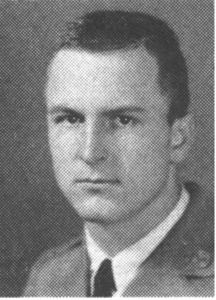Scroll of Honor – James Tinsley Whitney
Recapturing Guam
Written by: Kelly Durham
Perhaps James Tinsley Whitney knew about Guam from his classes at Union High School.  Maybe he had read about the island’s seaplane base serving the famous clippers of Pan-American World Airways. Even if he had, it is unlikely that Whitney would have linked his future to that far away island in the western Pacific.
Maybe he had read about the island’s seaplane base serving the famous clippers of Pan-American World Airways. Even if he had, it is unlikely that Whitney would have linked his future to that far away island in the western Pacific.
Whitney, a member of Clemson’s Class of 1939, was an industrial education major from Union. He played football as a freshman and was a member of the Block C Club. He served on the YMCA Council, was an officer in the Union-Clemson Club, and marched with the Sophomore, Junior and Senior Platoons as one of the best-drilled cadets in his class.
Following graduation, Whitney took a job as the shop instructor at Walterboro High School, where he soon noticed the school’s music teacher, Dorothy Mae Graham. Whitney, who had completed ROTC training at Clemson, entered the Army on March 5, 1942. In June, he and Dorothy were married.
Lieutenant Whitney was assigned to the 307th Infantry Regiment of the 77th Infantry Division. The division trained in the States for nearly two years before shipping out for Hawaii in February 1944. In Hawaii, the division trained for amphibious operations and jungle warfare until early July when it departed for Guam.
Guam, the largest of the Mariana Islands in the western Pacific, had been a territory of the United States since its brief war with Spain in 1898. The Navy exercised administrative control over the island, which included a refueling station for merchant and warships traveling to and from the Philippines, a Navy yard, and a Marine Corps barracks. In addition, a trans-Pacific cable communications station was established on Guam along with Pan-American’s seaplane facility. On December 10, 1941, following the daring attack on Pearl Harbor, Japanese forces stormed ashore and captured Guam, making it part of Japan’s Pacific defense perimeter. Now, the United States intended to take it back.
American military leaders recognized the value of Guam, as well as nearby Tinian and Saipan, as a location for airbases from which the Army Air Force’s new B-29 Superfortress bomber could fly missions against the Japanese home islands. The invasion of Guam and its recapture would allow devastating air raids to be conducted against Japan’s major war industries and cities.
The 77th Infantry Division assaulted Guam on July 21. Landing craft carried the soldiers only as far as the reef. From there, the troops had to wade ashore through the surf. Despite this soggy beginning, Whitney’s division secured the beachhead and on July 28th linked up with the 3rd Marine Division. By July 30, the Japanese airfield at Orote and the harbor at Apra had been captured.
On August 3, while battling Japanese defenders at Mount Barrigada, Whitney was killed in action. He was awarded the Bronze Star for gallantry and the Purple Heart. In January 1945, the airfields that Whitney had helped capture were expanded to accommodate B-29s and their strategic bombing campaign against Japan.
First Lieutenant James Tinsley Whitney was survived by his wife then serving as executive secretary of the Colleton chapter of the American Red Cross, his parents, a brother serving in the Merchant Marine, and a sister. Whitney is buried in the National Memorial Cemetery of the Pacific in Hawaii.
For more information about First Lieutenant James Tinsley Whitney see:
https://soh.alumni.clemson.edu/scroll/james-tinsley-whitney/
For additional information about Clemson University’s Scroll of Honor visit:
https://soh.alumni.clemson.edu/
